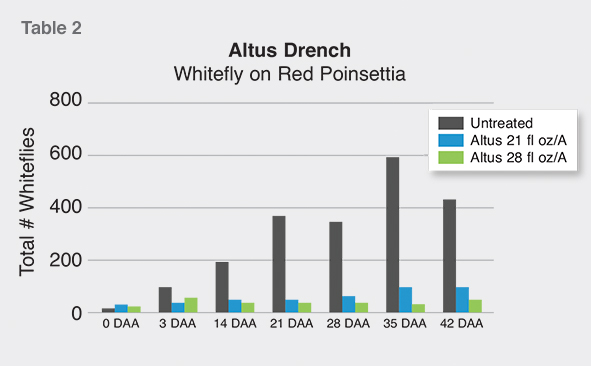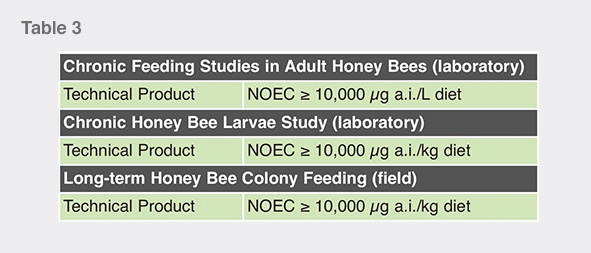Altus – Answering Market Challenges with a New Pest Control Solution
Changes in regulations and recent shifts by big box retailers have stripped growers of some of their most effective tools to control insect pests on their crops. Meanwhile, pests like whiteflies and aphids continue to develop resistant populations that can withstand more than triple the amount of insect control products they could a decade ago. Coupled with consumer dialogue around bee health, professional greenhouse and nursery growers have many very difficult, but not insurmountable, challenges. With that in mind, Envu has seen a growing need for more innovative pest control solutions that manage insect pests, while also having low impact on beneficial arthropods, as well as certain pollinators like honey bees and bumble bees. To help address some of those challenges, Envu spent the past eight years developing flupyradifurone, the active ingredient featured in Altus. Flupyradifurone belongs to a unique class of chemistry called butenolide. Butenolides are chemically distinct from neonicotinoids, yet possess a similar ability to permeate throughout the plant and provide lasting protection against certain pests for extended periods of time. In the following article, we’ll walk you through that development process and outline some of the key benefits that growers can glean from integrating Altus into their existing IPM program.
Altus application flexibility
Our goals in developing Altus were twofold. First, to introduce an easy-to-use solution for the control of sucking pests, and second, to minimize key grower challenges regarding flexibility, efficacy and selectivity. The result was a series of benefits that contribute to application flexibility and an operation’s bottom line:
- No restriction to time of application
- Flexible application before, during or after bloom
- Short, four-hour re-entry interval to help simplify operations
- 12-hour re-entry interval in California
- Good compatibility with Integrated Pest Management programs
- Spray or drench applications to match the best control method with the target pest and crop
- Rapid solubility and good mixability in the spray tank
- Labeled uses in greenhouses and nurseries on ornamental plants, vegetable transplants and indoor vegetable production
Altus trial data & efficacy
In the past three years, there were 73 studies conducted across labs, greenhouses and nurseries to assess the efficacy of Altus in production ornamental settings (Table 1). Altus provides strong control of most sucking pests – such as whiteflies, aphids, leafhoppers, mealybugs, psyllids and scales – with excellent speed of action, quick feeding cessation and long residual (four to six weeks).
Research trials also showed that Altus provided control against neonicotinoid-resistant populations of insects, including whiteflies and aphids. The chemical structure of butenolides dictate a unique binding site of the molecule to the insect nervous system, which provides differentiating activity.
Altus shows little or no cross-resistance in neonicotinoid-resistant strains of many sucking pest species. Altus is also capable of both systemic and translaminar movement. As a foliar spray, it’s efficacious on insects feeding on the underside of the leaf surface. As a drench, it’s taken up through the roots for rapid distribution throughout the entire plant to provide fast and lasting protection.
These properties make Altus a good solution for control of pests, such as whiteflies. In the poinsettia trial shown in Table 2, we saw impressive whitefly control that lasted weeks after a single drench application – even at lower rates.
 |
 |
Selectivity flupyradifurone
The selectivity of flupyradifurone was one of the primary reasons we introduced Altus to the ornamentals market. It offers excellent control of sucking pests and has been classified by the EPA as a reduced risk product.
Envu conducted extensive lab and field testing to assess the intrinsic toxicity of flupyradifurone for honey bees, bumble bees and non-target arthropod populations. Results indicate that Altus doesn’t adversely affect honey bee colonies, hive vitality, honey bee health or overwintering when used according to label instructions. Table 3 illustrates that Envu researchers exposed honey bees to the maximum amount of active ingredient as established by the test parameters and still didn’t see any adverse effects.
| Altus has no application restrictions when honey bees, bumble bees or blooms are present – contributing to increased flexibility and a broad application window for growers. Altus is not registered in all states. Always read and follow label instructions. For more information about Altus, visit us.envu.com/Altus. |  |
Article originally published in GrowerTalks, June 2017.
| |
